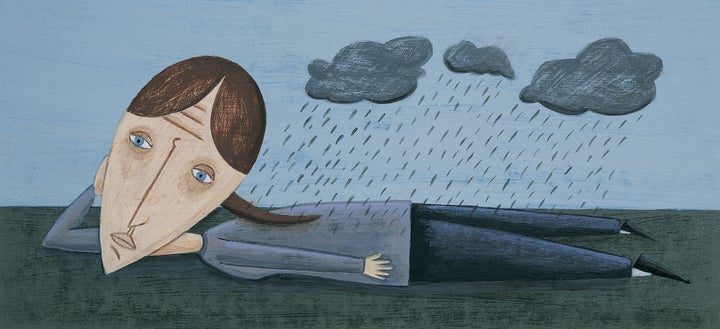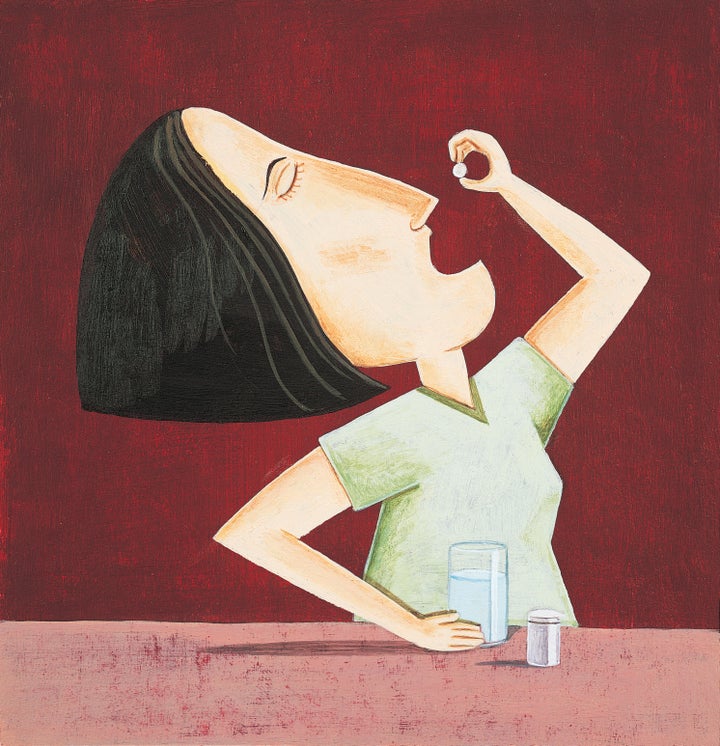
If you have a period, you might also experience premenstrual syndrome (PMS) to some degree. But for those who have premenstrual dysphoric disorder (PMDD), the week before and sometimes during their period can be horrendous: symptoms can be so severe they result in suicidal thoughts, or pain so strong they have to visit hospital.
While it can have devastating mental and physical symptoms, many people do not know PMDD exists. You won’t, for instance, find an NHS Choices page for the disorder, and it’s not known how many people suffer with it – some estimates suggest that one in 20 women are impacted, others that between 3 and 8% of women of reproductive age have it.
This lack of visibility has obvious implications for both diagnosis of PMDD and sharing you have the condition with your employer or loved ones. This can be even more difficult for non-binary people and trans men, who may also find that resources don’t use inclusive language.
Some people are, however, working to improve understanding of this little-talked-about illness: the inclusive Facebook page called Vicious Cycle: Making PMDD Visible has over 10,000 likes; there’s a dedicated app for people to track their symptoms; and multiple clinical trials are investigating better treatment options. In May this year, the World Health Organisation (WHO) added PMDD to the International Statistical Classification of Diseases and Related Health Problems, validating it as a legitimate medical diagnosis worldwide.
HuffPost UK spoke to three people diagnosed with the condition – and asked them what they want others to know. They hope in sharing their stories, that other PMDD sufferers will no longer be left in the dark.

It can have a huge mental impact.
A year or so after starting her period at 14, Claudia Lang’s mental health deteriorated massively. “I’d always been a happy kid,” she explains, “and all of a sudden I was having suicidal thoughts.” It wasn’t until she turned 17 that she began to realise these bouts of depression were linked to her menstrual cycle.
There are dozens of symptoms associated with PMDD such as mood swings and feeling upset, tearful, anxious, hopeless, tense or on edge. Sufferers might also have difficulty concentrating, feel overwhelmed, have a lack of energy, and in some cases, experience suicidal thoughts.
Anna, 26, who asked we didn’t include their second name, started their period early, at the age of 10, and over time has noticed worsening symptoms including mood changes. Five days before their period their mood decline is very noticeable – “and the last two [days] I can be low enough to the point of being suicidal,” explains Anna, who identifies as non-binary.
Freya Crick, 20, was just starting out at university when she noticed she was struggling with her mental health – but only around the time of her period. “I’ve always noticed that every month I’ve had a week or two where it’s been really bad mentally,” she says.
There are physical symptoms too.
Physical symptoms of PMDD include breast tenderness or swelling, pain in the muscles and joints, headaches, bloating and sleep problems. For all of the people we spoke to, these pains can be extreme.
Lang, now 21, has had to deal with debilitating period cramps that left her “in complete agony” during her period, and also the week before.
“I couldn’t get out of bed, I had weird flu-like symptoms, nausea, hot flashes, and was incapable of thinking straight,” says Lang, from Glasgow. On a particularly bad day she would have up to five showers to help with the physical symptoms and spend the rest of the day in bed. She couldn’t read, write or watch TV. The pain was unbearable.
Meanwhile Crick says she experienced such extreme period pain that she had to go to hospital.
PMDD is heavily stigmatised.
Periods are often not openly talked about – a recent survey by Plan International revealed that one in five young women had been period-shamed. But with PMDD, the mental health element brings an extra level of secrecy. This stigma stopped Lang from speaking to others about her symptoms – which meant that for years, she thought her experience was “normal”.
“People have this idea of what periods are like and they sign off on it,” she says. “For a long time I’d tell friends or family I was emotional and in a dark place, and they’d think: ‘Well that’s periods’.
“They wouldn’t take me seriously.”

It can impact people’s ability to work.
The World Health Organisation defines PMDD as “a pattern of mood symptoms (depressed mood, irritability), somatic symptoms (lethargy, joint pain, overeating), or cognitive symptoms (concentration difficulties, forgetfulness) that begin several days before the onset of menses, start to improve within a few days after the onset of menses, and then become minimal or absent within approximately one week following the onset of menses”.
It adds that the symptoms are severe enough to “cause significant distress or significant impairment in personal, family, social, educational, occupational or other important areas of functioning”.
Many companies have sickness policies whereby human resources (HR) get involved if an employee is off sick more than a certain number of times or days throughout the year. This can leave many people living with chronic illness or pain, struggling into work when they are unwell – and life with PMDD is no exception.
Anna says that it is something they are acutely aware of – and as a result they “try and push through”, even if the pain is unbearable or their mood is at rock bottom. “I can cope to an extent but it definitely impacts my work,” they add, before noting: “Because PMDD is not well known, it’s not something I’d be comfortable explaining to work.”
Crick explains that she missed four months of university because of her PMDD. Things have been a lot better since she began taking antidepressants, she notes. “Therapy helps me push through,” she adds. “I’ve managed to become a lot more productive now.”
Getting a diagnosis can be tough.
Everyone HuffPost UK spoke to cited lengthy processes to get a diagnosis. “I wasn’t taken seriously for years, even once being turned away by the hospital because it wasn’t seen as a big deal,” says Lang. “I had to fight every step of the way to get a Mirena coil [an intrauterine device].”
After years of trying to get answers through the NHS, Lang turned to private healthcare, where she was told she had endometriosis. “I was like, okay that’s what I have then,” she says. Then a laparoscopy (keyhole surgery) revealed that she didn’t have endometriosis after all. “After I woke up from the surgery they told me it was PMDD. I had no idea what it was,” she adds.
Despite the conflicting messages, Lang now says “it feels so wonderful to have a diagnosis and know what it is”.
Anna agrees that it was tough finding a medical professional who knew what they were dealing with. “The amount of GPs you have to go through to get a referral is a bit of a nightmare,” they say. Finally getting a diagnosis is a relief.
“It gives it a name. Just knowing it’s a legitimate thing and it’s not just me, other people have this as well, and knowing I’m not losing my mind at all and that it’s something that can be managed [is important],” they say.

Self-care is important.
There is no specific cure for PMDD, so management of symptoms and self-care is crucial. Lang says she still experiences emotional difficulties around the time of her period. “I try to avoid things that will make me upset or stressed,” she explains.
The mental health charity Mind offers some examples of how people could practice self-care including: rearranging stressful events and tasks for another time, planning relaxing activities that you know improve your mood, putting in place a support plan that sets out how you would like to be supported in a particular situation, and creating a self-care box.
But for people struggling with depression and experiencing suicidal thoughts during this time, it’s really important to see a GP or seek medical help. It’s likely you will be prescribed antidepressants, specifically selective serotonin reuptake inhibitors (SSRIs).
It might take time to find the right treatment.
Anna has tried all kinds of treatment options, including three types of the combined contraceptive pill and two of the mini pill. Hormones are prescribed to ”suppress ovulation” and, as a result, suppress related hormone fluctuations, which can help relieve PMDD symptoms.
“From a non-binary/trans point of view, one of the possible side effects of oral contraception is breast swelling, pain and growth,” says Anna. “This exacerbated my gender dysphoria, which is why I had to come off it.” Anna also tried two different types of antidepressant which stabilised their mood for a while; but then they began to experience terrible nightmares. They also note the drugs became less effective the longer they took them.
“It can be frustrating trying all these options,” says Anna, as much of the time you have to try them for three months to determine whether they work or not. “It can take years [to find the right treatment]. But some people do find options a lot quicker.”